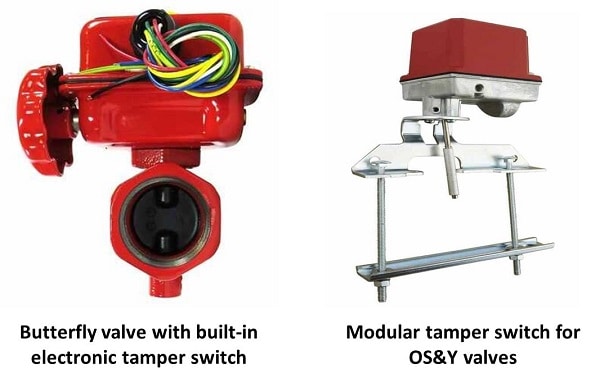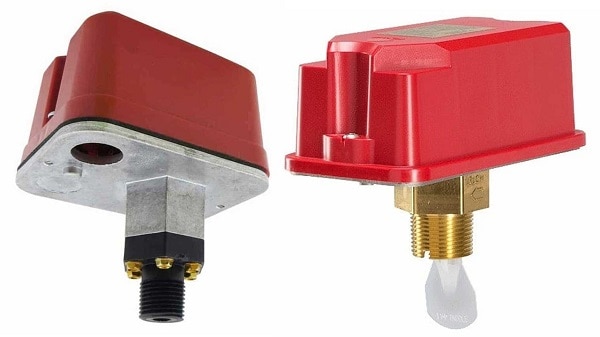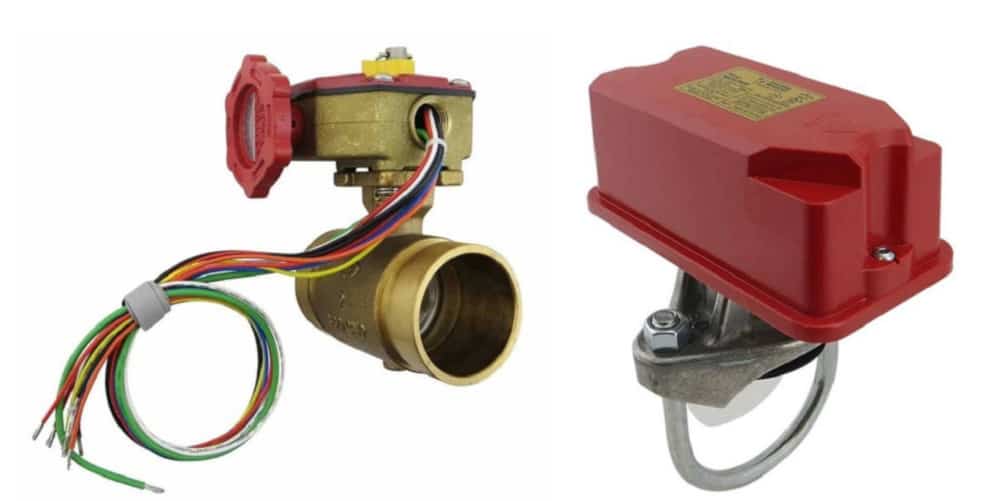A fire sprinkler pressure switch, water flow detector, or tamper switch requires regular ITM
When equipped with electric supervision devices, modern fire sprinkler systems provide real-time monitoring of their status and alert building staff and others to problems or emergencies. Two types of switches are key here: tamper switches and water flow detection switches.
Tamper switches warn building staff when a control valve is closed. Whether it happens intentionally or accidentally, closing the fire protection control valve effectively turns off the sprinkler system. Tamper switches help ensure that fire sprinklers are always operational in an emergency.
Water flow detection switches (aka water flow detectors) raise the alarm when water is flowing, typically from an activated fire sprinkler head. An activated sprinkler is an emergency whether it happens because of a fire or damage. These detectors ensure a quick response by building staff and first responders.
For more detail on the differences between these devices, check out our previous blog.
Most fire sprinkler system components need regular inspection, testing, and maintenance (ITM) to ensure that everything stands ready to protect lives and property. NFPA 25: Standard for the Inspection, Testing, and Maintenance of Water-Based Fire Protection Systems contains the industry-standard ITM rules adopted by most legal jurisdictions. This article walks you through the NFPA 25 tasks for tamper switches and water flow switches.
Electric supervisory devices provide vital oversight of your sprinkler system. QRFS has a wide selection of supervised butterfly valves, an add-on switch for post-indicator and butterfly valves, and an add-on switch for OS&Y valves—perfect for new construction, retrofits, or repairs. Also, shop our pressure switches, or choose from flow switches for pipes from 1″ to 8″.
Tamper switch inspection, testing, and maintenance
A tamper switch detects control valve closure. If a control valve is shut—whether maliciously, accidentally, or as part of routine system maintenance—the fire sprinkler system is nonfunctional. The National Fire Protection Association (NFPA) report “US Experience with Fire Sprinklers” states that sprinkler systems were shut off in about 3/5th of 2015-2019 cases where sprinklers failed to operate in a fire.
Read our previous blog for more information about the role tamper switches play in fire sprinkler systems.

The huge risk posed by a shut-off system is why tamper switches alert building staff of a closed valve, often via the fire alarm panel. Like any other system component, these devices need regular care to perform their job reliably. NFPA 25 requires two recurring ITM tasks:
- Inspect tamper switches quarterly
- Test tamper switches semiannually
Quarterly inspection of tamper switches
The inspection task for tamper switches is simple. Every quarter, NFPA 25 (all references are from the 2020 edition) requires the inspector to visually confirm that:
- Proper electronic supervision is in place on control valves (3.2.2)
- The supervisory switch is undamaged (3.2.1.3)
That’s it!
Semi-annual testing of tamper switches
Every six months, NFPA 25 requires a test of control valve tamper switches. This test is carried out by operating the valve’s handwheel to move it from its normal position. Spinning it only a few revolutions should trigger a signal:
From the 2020 edition of NFPA 25
13.3.3.5.2 A distinctive signal shall indicate movement from the valve’s normal position either during the first two revolutions of a handwheel or when the stem of the valve has moved one-fifth of the distance from the normal position.
Additionally, the alarm signal should be continuous and persistent. It should not turn off until the valve is returned to the normal position (13.3.3.5.3).
ITM for fire sprinkler flow and pressure switches
There are two types of fire sprinkler flow switches—and one can do more than spot flowing water—but both detect activation of the sprinkler system (and other possible causes of pressure or flow changes).
A paddle- or vane-type fire sprinkler flow switch generates a signal when flowing water pushes a small paddle or vane. Pressure switches, on the other hand, use a diaphragm to create a signal when system pressure changes.

Both of these devices indicate some variety of emergency, possibly an activated sprinkler or a burst pipe. They are attached to the sprinkler system through a hole drilled in the pipe or a small tee. The difference lies in how they measure changes in the piping. Each switch type has its advantages and drawbacks, which you can learn more about in this blog.
But crucially, pressure switches are necessary for dry and preaction sprinkler systems because vane- or paddle-type detectors may break with a sudden surge of water in those systems. Additionally, pressure switches can detect changes in the compressed gas pressure that must be maintained in these system types, spotting leaks or nonfunctioning air maintenance pumps.
The ITM schedule for flow and pressure switches is simple:
- Every quarter, visually inspect the devices to make sure they aren’t damaged
- Twice a year, test them, usually by flowing water through the test connection
Quarterly inspection
Like valve tamper switches, flow and pressure switches should be inspected quarterly per NFPA 25 (13.2.4.4.1). This visual inspection simply verifies whether the devices are in place and appear undamaged.
Semi-annual testing
Similar to tamper switches, pressure and flow switches must also be tested regularly to verify they will initiate a signal when the sprinkler system activates. These tests happen at the same interval as tamper switches—semiannually.
NFPA 25 generally wants inspectors to flow water from the inspector’s test connection to verify the proper function (13.2.4.5). There are some exceptions to this, which we’ll discuss momentarily. For many pressure switches and vane- or paddle-type water flow detectors, the test is the same (13.2.4.1-2):
- The test connection is opened. Water flows.
- Within 90 seconds of opening the test connection, the switch should activate.
- Within five minutes, an audible alarm should start. It should not stop until the flow stops.
The 90-second and five-minute wait periods are used because many devices, such as the Safe Signal WFDTN Waterflow Detector, have built-in time delays to prevent false alarms. An alarm will only trigger if the flow is persistent.
But sometimes, it isn’t practical or possible to open a test connection. For instance, NFPA 25 acknowledges that freezing conditions make flow tests inconvenient (13.2.4.6). Moreover, the test connection method should not be used for preaction, dry-pipe, or deluge systems. Opening the test connection to flow water could trip the whole system, requiring a complicated reset (13.2.4.8).
In all of those cases, NFPA 25 permits the use of a “bypass loop.” NFPA 13: Standard for the Installation of Fire Sprinkler Systems (2022 edition) specifies the installation of this loop of pipe in dry systems specifically for testing alarms (16.11.5).
Some modern vane-type flow switches also have built-in test functions that don’t require you to flow water. NFPA 25 does allow automatic testing, but with the caveat that a full flow test must happen at least every three years (4.6.6.4.1-2). While an automatic test function is handy, it doesn’t give the same information as a flow test. Good documentation—accurately submitted by fire protection pros and maintained by the facility owner—ensures that the required tests happen on time.
Fire sprinkler flow & tamper switch maintenance is simple but crucial
Fire sprinkler supervisory switches play an essential role: they alert staff to vital changes in the fire sprinkler system. Fire sprinkler flow switches, which work by monitoring flow or pressure, alert when a sprinkler activates, or damage causes flow or pressure differences. Tamper switches generate a signal when the control valve is closed, ensuring the system works in an emergency.
Like any other part of a fire sprinkler system, these switches need regular ITM. And while these tests are pretty straightforward, a qualified professional needs to perform them. Becoming qualified for visual inspections isn’t too difficult—but tests are another story. Opening a test connection, for instance, can have all kinds of consequences, depending on the system.
Keep your systems running, maintained by a qualified individual, and up to code! And if you need system supervision components, shop our selection of:
- Butterfly valves pre-wired for supervision
- Add-on tamper switches for post-indicator and butterfly valves
- Add-on tamper switches for OS&Y valves
- Pressure switches and flow switches
If you have questions or need help placing an order, call us at (888) 361-6662 or email support@qrfs.com.
This blog was originally posted at blog.qrfs.com. If this article helped you, check us out at Facebook.com/QuickResponseFireSupply or on Twitter @QuickResponseFS.



We are building a parking garage that attaches to 2 other parking garages. The series of 3 garages connected act as one big garage. We have a wet pipe fire suppression system with 2 inch hose outlets. The existing 2 garages do not have their flow switches or tamper switches connected, therefore, they are unabled to be monitored.
In our new garage, the prime contractor decided to cut back the wires hanging out of the switches back to 2inch length because they were an “eye sore” and “won’t be connected to power anyway”. I suggested they either connect a metal J box and wrap up the wires inside the J box or else neatly roll up the wires so they can readily be used to connect down the line when the facility decided to connect all flow and tamper switches to power later.
Did they violate code by cutting the wires back real short? Who is correct?
Thanks for your expertise in this.
Michael — First, we need to separate out flow and tamper switches. In either case, it is less about how long the wires are vs. whether the switches are *connected* and will sound an alarm. Otherwise, here is some relevant info based on NFPA standards:
Regarding flow switches/alarms:
From the 2022 edition of NFPA 13
16.11.2.1 Local Waterflow Alarms.
A local waterflow alarm shall be provided on every sprinkler system having more than 20 sprinklers.
Section 7.7 states:
Mechanical waterflow alarms must “result in an audible alarm on the premises within 5 minutes after such flow begins and until such flow stops.”
Electrical waterflow alarms must “result in an audible alarm on the premises within 100 seconds after such flow begins and until such flow stops.” Again, this is not about the length of the wires but whether the flow switch sounds an alarm.
Regarding tamper switches (that monitor control valves):
A system could get away without electrically monitored control valves, but:
1. Why do that when the system seems to have them?
2. Unsupervised (and unlocked) control valves must be more frequently inspected to ensure they are free of damage and in the open position (weekly vs. monthly or quarterly).
Electrical supervision is the best option — and the switches obviously must be connected to achieve that. We aren’t 100% sure which equipment you are referring to in your question (both?) but hope this info helps.
How to switch off the electronic pressure switches for deluge valves?
Simon — Unfortunately, we cannot provide that information on deluge valves, other than to suggest that you consult the manufacturer, manufacturers’ instructions, or a qualified local fire protection pro. Thanks for reading!